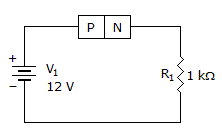Discussion
Home ‣ Electronics ‣ Semiconductor Principles Comments
- Question
What is an energy gap?
Options- A. the space between two orbital shells
- B. the energy equal to the energy acquired by an electron passing a 1 V electric field
- C. the energy band in which electrons can move freely
- D. an energy level at which an electron can exist
- Correct Answer
- the space between two orbital shells
- 1. What is the voltage across R1 if the P-N junction is made of silicon?

Options- A. 12 V
- B. 11.7 V
- C. 11.3 V
- D. 0 V Discuss
- 2. Which material may also be considered a semiconductor element?
Options- A. carbon
- B. ceramic
- C. mica
- D. argon Discuss
- 3. Silicon atoms combine into an orderly pattern called a:
Options- A. covalent bond
- B. crystal
- C. semiconductor
- D. valence orbit Discuss
- 4. Ionization within a P-N junction causes a layer on each side of the barrier called the:
Options- A. junction
- B. depletion region
- C. barrier voltage
- D. forward voltage Discuss
- 5. When an electron jumps from the valence shell to the conduction band, it leaves a gap. What is this gap called?
Options- A. energy gap
- B. hole
- C. electron-hole pair
- D. recombination Discuss
- 6. If conductance increases as temperature increases, this is known as a:
Options- A. positive coefficient
- B. negative current flow
- C. negative coefficient
- D. positive resistance Discuss
- 7. Minority carriers are many times activated by:
Options- A. heat
- B. pressure
- C. dopants
- D. forward bias Discuss
- 8. Forward bias of a silicon P-N junction will produce a barrier voltage of approximately how many volts?
Options- A. 0.2
- B. 0.3
- C. 0.7
- D. 0.8 Discuss
- 9. A commonly used pentavalent material is:
Options- A. arsenic
- B. boron
- C. gallium
- D. neon Discuss
- 10. What is a type of doping material?
Options- A. extrinsic semiconductor material
- B. pentavalent material
- C. n-type semiconductor
- D. majority carriers Discuss
Semiconductor Principles problems
Search Results
Correct Answer: 11.3 V
Correct Answer: carbon
Correct Answer: crystal
Correct Answer: depletion region
Correct Answer: hole
Correct Answer: negative coefficient
Explanation:
A negative temperature coefficient (NTC) occurs when the thermal conductivity of a material rises with increasing temperature, typically in a defined temperature range.
Note: The reciprocal of electrical Resistance is called Conductance.
Correct Answer: heat
Correct Answer: 0.7
Correct Answer: arsenic
Correct Answer: pentavalent material
Comments
There are no comments.More in Electronics:
Programming
Copyright ©CuriousTab. All rights reserved.
